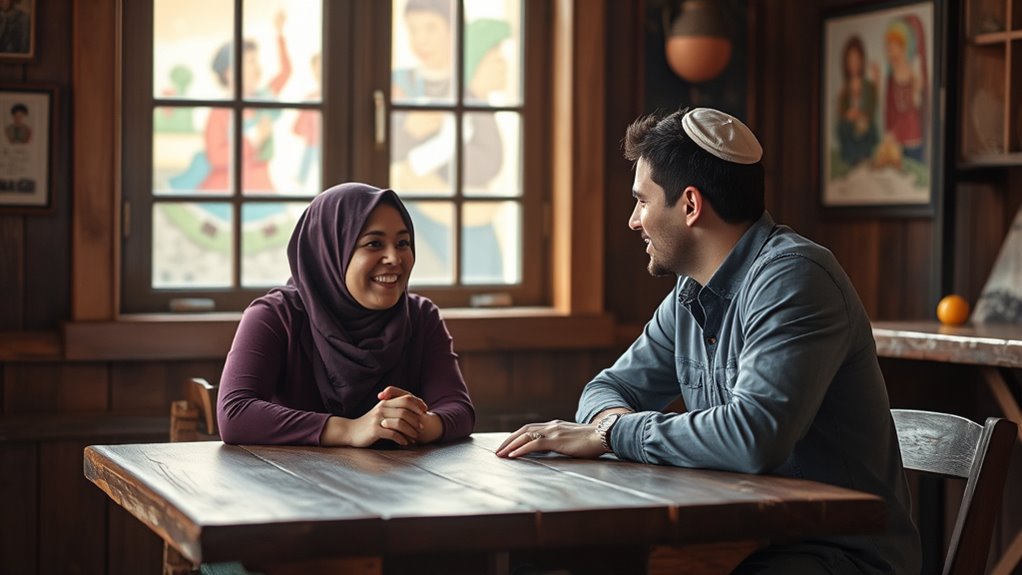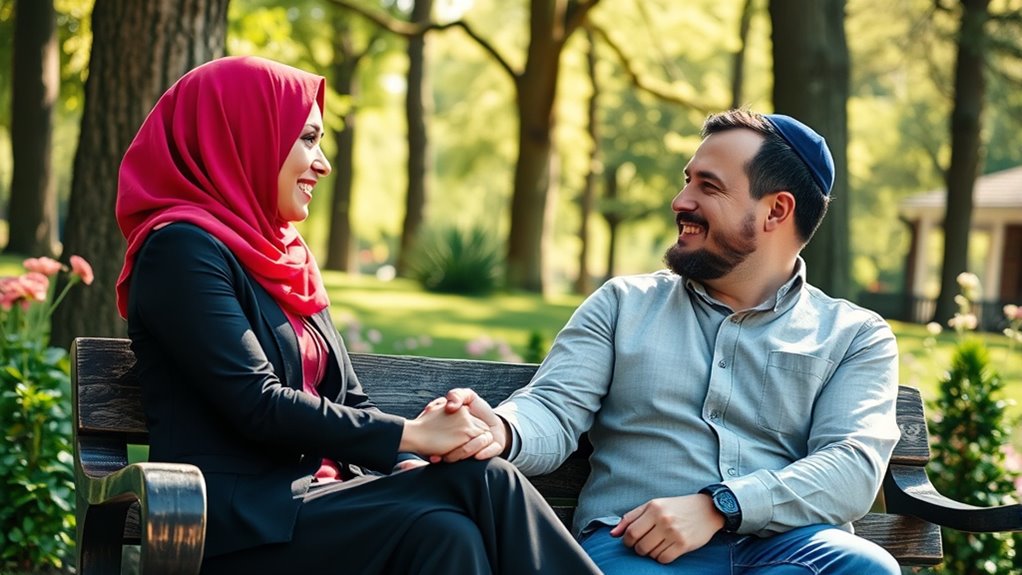Navigating interfaith relationships involves open communication, mutual respect, and patience. You should discuss beliefs, traditions, and boundaries early on, finding common ground while honoring each partner’s identity. Celebrating shared rituals and blending traditions help build connection. Understanding and supporting each other’s faiths foster harmony. You’ll discover how to manage family influences, support children, and create inclusive community bonds as you strengthen your partnership with respect. More insights await if you continue exploring this important topic.
Key Takeaways
- Foster open, honest communication about beliefs, traditions, and boundaries to build mutual understanding and respect.
- Establish shared rituals and celebrate both faiths through inclusive holidays and family customs.
- Support religious literacy and encourage questions to promote understanding of each other’s beliefs.
- Practice active listening and address sensitive topics with patience to strengthen interfaith relationships.
- Engage in community and family activities that respect both faiths, fostering inclusivity and shared values.
Understanding the Growing Landscape of Interfaith Marriages

The landscape of interfaith marriages has been steadily expanding in the United States, reflecting broader social and cultural shifts. As more couples navigate religious differences, interfaith art and religious symbols become meaningful ways to honor both traditions. Displaying symbols like a cross intertwined with a Star of David or blending religious artwork fosters mutual respect and understanding. These visual elements help couples create shared spaces, turning religious diversity into a source of strength rather than division. The growing presence of interfaith art in homes and communities signals a broader acceptance of religious pluralism. This trend mirrors the increasing prevalence of interfaith relationships, where embracing diverse religious symbols becomes a essential part of building inclusive, harmonious families. Additionally, incorporating interfaith symbols into home decor can serve as a daily reminder of mutual respect and shared values between partners.
Recognizing Demographic Trends and Influences

Demographic shifts substantially shape the landscape of interfaith relationships in the United States. You’ll notice that interfaith demographics vary across age groups, with younger generations like Millennials more likely to have interfaith parents or partners. Non-Christian Americans, particularly those who identify as religiously unaffiliated or belong to minority faiths, show higher rates of interfaith relationships. Religious identity plays a pivotal role here; some groups, like Jewish Americans, have high interfaith marriage rates, while others, such as certain Protestant communities, tend to marry within their faith. These demographic trends influence how communities respond and adapt, affecting inclusion efforts and overall engagement. Recognizing these influences helps you understand the evolving religious landscape and the importance of fostering respect amid diversity. Understanding cultural intelligence can further enhance efforts to promote inclusion and mutual understanding in increasingly diverse interfaith contexts.
Common Challenges Faced by Interfaith Couples

Interfaith couples often face a range of challenges that can test their relationships and family dynamics. One major hurdle is negotiating interfaith identity, where each partner may feel a strong connection to their religion but struggle to find common ground. Religious stereotypes can also create misunderstandings or biases, making external acceptance difficult. You might encounter pressure from family members or communities who hold rigid views about interfaith relationships, leading to feelings of exclusion or judgment. Balancing religious practices and traditions within your household can be complex, especially when trying to honor both backgrounds. These challenges require patience and open-mindedness, but they can also spark important conversations about values, identity, and shared life goals. Recognizing and addressing these issues early helps strengthen your partnership.
Building Mutual Respect and Open Communication

You need to have honest conversations about your beliefs and values to build trust in your relationship. Respect each other’s personal beliefs, even if they differ, to foster understanding. Practice active listening to truly hear your partner’s perspective and create a safe space for open communication.
Honest Conversations Matter
Why do honest conversations matter so much in interfaith relationships? Because they foster cultural understanding and emotional resilience. When you speak openly about your beliefs, traditions, and feelings, you create a safe space for mutual respect. Honest dialogue helps you both navigate differences without judgment or assumptions, strengthening your connection. It encourages listening and empathy, which are essential for building trust. By addressing sensitive topics honestly, you avoid misunderstandings that could lead to resentment. These conversations also prepare you to handle external pressures and family dynamics more effectively. Understanding color accuracy and how it impacts perceptions can help you discuss differences in visual expressions of faith or cultural events. Ultimately, open communication nurtures a foundation of respect, ensuring you both feel valued and understood in your unique spiritual journeys. This honesty keeps your relationship resilient and rooted in genuine mutual appreciation.
Respect Personal Beliefs
Building mutual respect begins with recognizing that each person’s beliefs and practices are integral to their identity. You can foster this by practicing interfaith etiquette—showing genuine interest and respect for your partner’s faith. Open communication is key; ask questions without judgment and share your own beliefs honestly. Remember, religious diplomacy involves navigating (or steering through) differences with sensitivity, avoiding dismissive attitudes. Use these strategies to create an environment where both faiths are valued:
| Respectful Approach | Implementation |
|---|---|
| Active Listening | Focus fully when your partner shares. |
| Respect Boundaries | Honor personal beliefs without pushing. |
| Celebrate Differences | Find common ground in shared values. |
| Support Religious Practices | Encourage participation without pressure. |
Additionally, understanding the importance of interfaith etiquette can help in cultivating mutual respect and creating a harmonious relationship.
Active Listening Skills
Active listening forms the foundation for respectful and open communication in interfaith relationships. By cultivating listening awareness, you focus fully on your partner’s words without interruption or judgment. This practice helps you understand their perspective and emotional state better. Incorporate empathy exercises by imagining yourself in their position, which deepens mutual understanding. When your partner shares their beliefs or feelings, respond with genuine interest and validation, rather than defensiveness. Ask clarifying questions to ensure clarity and demonstrate that you value their voice. Active listening encourages openness, reduces misunderstandings, and fosters trust. Remember, it’s not just about hearing words but truly engaging with your partner’s experiences. Additionally, understanding the nuances of Kia Tuning can serve as a metaphor for tuning into your partner’s needs and preferences more effectively. Over time, these skills build mutual respect, strengthening your relationship’s foundation.
Navigating Religious Practices and Family Traditions

When blending religious rituals, parenting, and family traditions, you need to find common ground that respects both partners’ beliefs. You’ll face choices about which practices to include, modify, or combine to create meaningful traditions. Steering through these decisions requires open dialogue and a willingness to adapt as your family grows. Incorporating key components of sound design, such as meaningful rituals and ambient sounds, can also help create a sense of harmony and shared identity within your family.
Blending Religious Rituals
How do interfaith couples navigate the complexities of blending religious rituals and family traditions? You often find yourself balancing diverse practices, creating new rituals, and respecting each other’s sacred customs. Ritual adaptation is key, allowing you to honor traditions like holiday celebrations while incorporating elements of interfaith cuisine that reflect both backgrounds. You might combine prayers, share symbolic meals, or alternate observances to foster unity. Open communication helps you negotiate expectations and avoid misunderstandings. Consider these approaches:
- Developing personalized rituals that incorporate core elements from each faith
- Celebrating holidays together with a blend of customs and foods
- Respecting family traditions without feeling pressured to conform entirely
- Creating new, shared practices that reflect your combined spiritual values
Research shows that interfaith relationships often thrive when both partners actively engage in mutual understanding and respect. This flexible approach helps you build a meaningful, inclusive family culture rooted in mutual respect.
Parenting and Tradition
Guiding religious practices and family traditions can be one of the most complex aspects of parenting in interfaith families. You may face decisions about how to honor both religious traditions while raising children. Interfaith parenting involves balancing multiple beliefs, which can create meaningful opportunities for learning and respect but also potential conflicts. To navigate this, you might establish shared rituals that combine elements from each faith or alternate religious celebrations to give children a broader spiritual perspective. Open communication is essential—discuss your values and expectations openly with your partner. Remember, creating a flexible approach to religious tradition allows your children to develop their own identities while respecting their diverse heritage. Additionally, understanding the legal considerations relevant to religious practices and family traditions can help prevent conflicts and ensure that your family’s rights and responsibilities are clear. Ultimately, your goal is to foster understanding and respect for both faiths within your family.
Supporting Children in Interfaith Families

Supporting children in interfaith families requires careful navigation of religious identities and traditions. You need to foster open interfaith dialogue that promotes understanding and respect. Prioritize enhancing religious literacy within your family to help children appreciate different beliefs without feeling conflicted. Clear communication about each parent’s faith traditions helps children develop their own sense of identity. Consider these approaches:
- Establish shared rituals that honor both faiths, creating inclusivity.
- Encourage questions and honest discussions about religious differences.
- Consult religious leaders or counselors to support balanced spiritual development.
- Reinforce the importance of respecting diverse beliefs, emphasizing love and understanding over division.
- Understanding the interfaith dynamics can help families develop more harmonious and respectful relationships.
Fostering Community Inclusion and Connection

Fostering community inclusion and connection for interfaith families requires intentional effort from religious communities and families alike. Engaging in interfaith dialogue helps build understanding and break down barriers. Community outreach initiatives, such as inclusive events and educational programs, create welcoming environments where families feel valued. To inspire emotional connection, consider this table showing diverse experiences:
| Feeling of Belonging | Community Support | Interfaith Dialogue |
|---|---|---|
| Appreciated | Fears dismissed | Shared stories |
| Connected | Outreach efforts | Respectful talks |
| Accepted | Open-minded leaders | Personal growth |
| Valued | Inclusive rituals | Mutual understanding |
| Supported | Celebrating differences | Building trust |
Additionally, incorporating interfaith inclusivity practices can further strengthen the bonds within diverse communities.
Strategies for Maintaining a Strong and Respectful Partnership

Maintaining a strong and respectful interfaith partnership requires deliberate communication and mutual understanding. You should prioritize open interfaith dialogue, creating a safe space to discuss beliefs, values, and boundaries. Respect each other’s spiritual boundaries, even when they differ, to foster trust and harmony. To strengthen your relationship, consider these strategies:
- Engage in regular, honest conversations about faith and traditions
- Establish shared rituals that honor both spiritual backgrounds
- Practice active listening to understand your partner’s perspective
- Support external community involvement that respects both faiths
Frequently Asked Questions
How Can Interfaith Couples Effectively Address External Community Pressures?
To handle external community pressures, you should practice boundary setting by openly communicating your needs and limits with others. Engage in community advocacy by sharing your story and promoting understanding, which can foster acceptance. Building support networks with like-minded couples or groups helps you feel less isolated. Stay confident in your choices, educate others about your relationship, and encourage respectful dialogue to reduce external pressures and strengthen your bond.
What Strategies Help Children Embrace Multiple Religious Identities?
To help children embrace multiple religious identities, focus on open communication and positive faith integration. Encourage their curiosity about both traditions and involve them in shared rituals from each faith. Respect their individual expressions of faith and create a supportive environment that celebrates diversity. By fostering understanding and allowing children to explore their religious identities freely, you strengthen their sense of belonging and develop a well-rounded, inclusive spiritual outlook.
How Do Interfaith Couples Decide Which Traditions to Prioritize?
You likely find that tradition collaboration and value negotiation guide your decision-making. By openly discussing which practices matter most, you create a shared understanding. Prioritizing traditions becomes a process of balancing personal significance with mutual respect. You might blend rituals or alternate celebrations, ensuring both perspectives are honored. This approach helps you forge a family identity rooted in compromise, making religious traditions meaningful and inclusive for everyone involved.
What Resources Are Available for Interfaith Families Seeking Support?
You can find valuable support through interfaith support groups that connect you with others steering similar challenges. Religious counseling offers personalized guidance to address conflicts and develop shared practices. Many faith communities and organizations provide resources, workshops, and online forums focused on fostering understanding and collaboration. By engaging in these resources, you’ll gain insight, build community, and strengthen your relationship while respecting both partners’ spiritual traditions.
How Can Religious Communities Become More Inclusive of Interfaith Families?
They say “it takes a village,” and religious communities can become more inclusive by fostering open interfaith dialogue and community education. You can host interfaith events, celebrate diverse traditions, and create welcoming spaces where couples feel valued. By promoting understanding and respect through these efforts, you help interfaith families integrate fully, strengthening the entire community and demonstrating that love and faith can coexist harmoniously.
Conclusion
By embracing your differences with open hearts and respectful dialogue, you’ll build a foundation stronger than any obstacle. Remember, your love is like a bridge connecting two worlds, creating a beautiful mosaic of shared faith and understanding. Keep communication honest and prioritize mutual respect, and you’ll turn challenges into opportunities for growth. Together, you can craft a harmonious future where diversity enriches your bond and love blossoms beyond boundaries.









